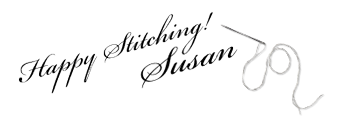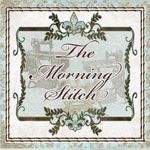Soooo...I do baby steps, like make chair pads for the bar stools at the kitchen counter. Maybe some of you have been wanting to make your own chair pads, so here's a tutorial on just how to do that.
Start by making a paper template of the chair seat using a piece of newspaper or brown craft paper. I found some paper filler in a shipping box we had. Any paper will do as long as it completely covers the seat.
Using a pencil, crayon, or chalk, trace around the edge of the seat. This doesn't have to be perfect, just let the chalk ride along the edge of the chair. I also indicated where the ties would be by marking either side of the back uprights.
See those two marks back there? That's for your tie placement.
Remove the paper template and draw a very generous seam allowance around your traced line. You could even add an extra 1" to the original traced line. (I'll explain why when we are closer to the finished project.) Now cut around the template on the seam allowance line.
Lay the paper pattern on your fabric. You will need 2 pieces, one for the top and one for the bottom of each chair. I had 2 chairs, therefore, the pattern says cut 4 pieces. You could double the fabric if the print doesn't need to be matched, like I did with my striped ticking fabric.
I wanted a bias cording around my chair pad, so I measured all around the edge of my chair, multiplied by 2 (for 2 chairs) and add about 8" for the length of cording I would need. I cut 2" wide strips on the bias, cutting enough strips so that when sewn together I got my required length. In my case, in need 122". When I sewed my strips together I had 138". Always better to have extra, than not enough!!
I used a firm 5/32" upholstery weight cording since I had that on hand, but you could use a softer cord, as well. It's best if that cording is about 1/4" to 3/8" thick, otherwise it is too thick.
I like to serge my cording because it trims the seam allowance to 1/2", but it is not necessary to serge, although you should trim the cord so that it has a 1/2" seam allowance.
Next, apply the cording all around the edge of the main piece starting at the center back edge, clipping the curves as you sew.
I overlap the cording at the start and finish so that it makes an even join. Your pad should look like this now.
Now you will need to make the ties. I cut 4 strips of the fabric at 3 1/4" wide by 25" long. Press the 2 short ends in about 1/4", then press the long edges of the ties halfway to the center, then press in half one more time so that the ties are about 3/4" wide. Stitch the long edges and short ends close to the edges of the ties.
Place the finished ties between the placement marks that you made on the main piece of fabric so that the ties face the center of the main piece. Stitch securely in place. These ties have a lot of strain on them, so stitch across the ties a few times.
I made a sandwich of lightweight quilt batting and the main piece of the chair pad. I cut the batting about a seam allowance smaller than the main piece. I lightly sprayed the batting with fabric adhesive and laid it on the WRONG side of the main piece. Do this to both the top and bottom. Then I stitched the top and bottom pieces together with RIGHT SIDES TOGETHER, using caution so as not to catch the ties. Make sure you lay the ties flat inside the pad toward the center.
Turn the stitched fabric right side out and then you have a "pita pocket". It should look like this. If you had used a thicker quilt batting, you could just sew it closed at this point and be done. But I chose to make my pads a little more cushy.
I stuffed my pads with fiber fill stuffing. Make sure you stuff the pad using small amounts at a time paying close attention to getting the stuffing all the way into the corners. Small even amounts will prevent the pad from being lumpy. I used quite a lot of stuffing because it will eventually flatten out.
Pin the opening closed. You can hand stitch for a more professional look, or because this was just for my personal use, I stitched the opening closed on the sewing machine. Stitch close to the fold and close to the cording for best results.
Here's my machine stitched version. Now, again, you can call it finished at this point, but I decided to add some buttons for a tufted look. This is why I mentioned that when adding seam allowance when cutting the main fabric pieces, you might want to allow a 1" seam allowance all around. When you add the button tufting, it makes the cushion shrink in a bit. So, decide before you add the seam allowance if you want the tufting finish and add accordingly.
The buttons are on the front and the back. Each side of the cushion has 4 buttons, so 8 buttons per cushion x 2 cushions = 16 buttons altogether.
I divided the cushion into thirds from side to side and front to back, marking with pins, then with my BFF purple disappearing marker.
I rough cut around the button about 3/8" bigger than the button. It doesn't need to be perfectly cut, but give yourself enough fabric to work with so that you don't struggle wrapping the fabric into the teeth of the button. Tip: Soak the circles for the covered buttons in a little water, then squeeze the water out. This will make wrapping the button form so much easier and will allow you to pull the fabric tighter into the teeth of the button form.
Now, grab a long needle with a large eye and some heavy duty, strong thread. I like to use the nylon cording that I use to string roman shades. I think you can buy that at most fabric stores that carry Roman shade supplies.
Using extreme caution, poke that long needle through the center of one of the purple marks on one side of the pad and come out into the center of the purple mark on the opposite side. I use excessively long strands of cord to do this so adding the button and tying it off are easy.
Thread the button onto the cord, pull the thread through to the opposite side, thread the button on the opposite side, then pull the needle back to the first side again. Pull the cord up SUPER tight by tying one knot. Now you can cinch it up tight to form the indentation of the tuft. The tighter you pull, the more indented the surrounding fabric becomes.
Repeat so that all 4 buttons have been secured.
Here's the finished product after the little extra effort of tufting. Looks great!!
See how the pad has shrunk up a bit? I would definitely make this a wee bit bigger next time to allow for the pull up of the tufting. But, I am happy camper. It's DONE!!
Another step toward the Vintage Farmhouse look that I dream of in my kitchen. Baby steps, girl...baby steps! I hope that I may have encouraged you to take a baby step toward one of your goals today.
Happy Baby Stepping!!!
































































